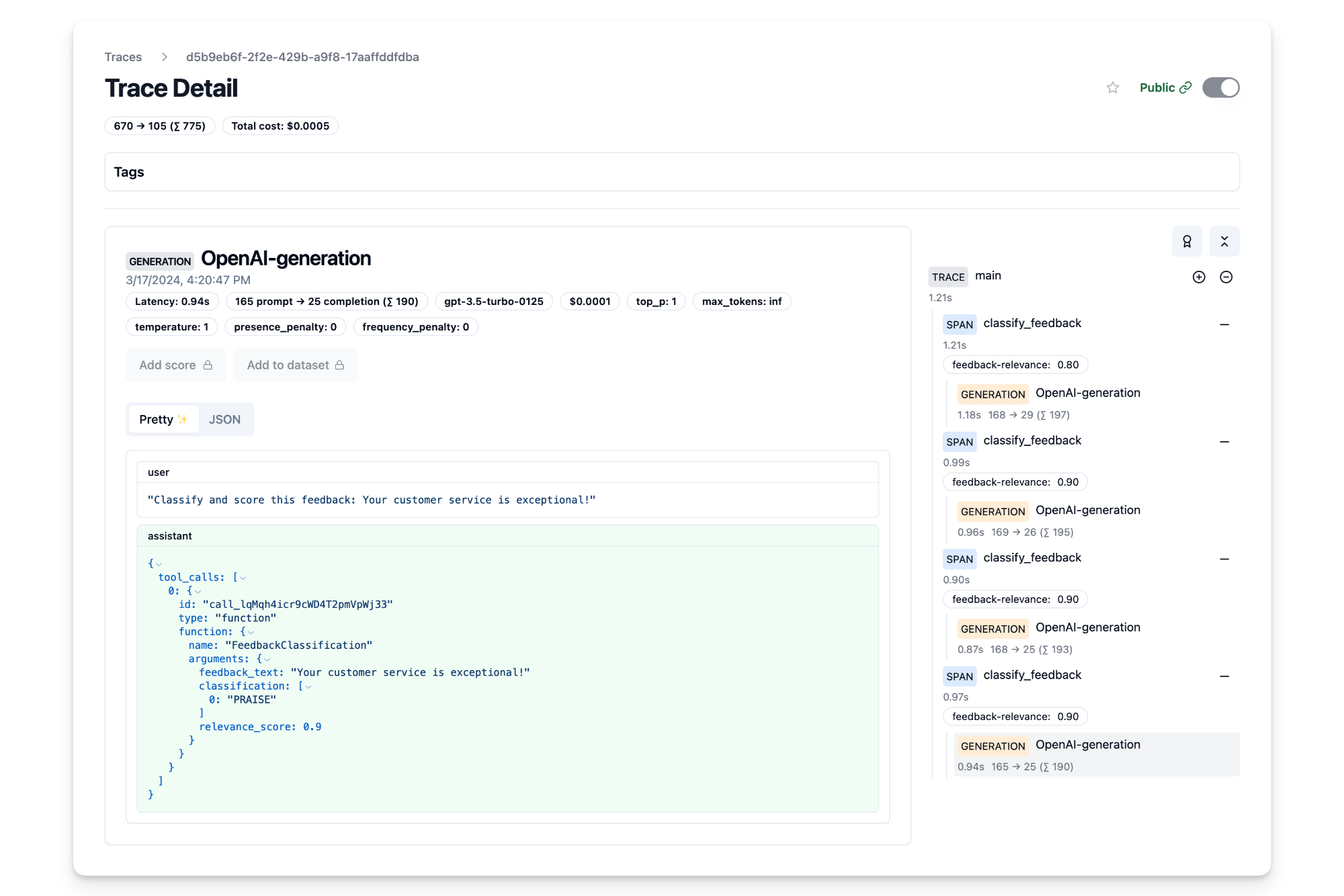Observability & Tracing with Langfuse¶
What is Langfuse?
What is Langfuse? Langfuse (GitHub) is an open source LLM engineering platform that helps teams trace API calls, monitor performance, and debug issues in their AI applications.

This cookbook shows how to use Langfuse to trace and monitor model calls made with the Instructor library.
Setup¶
Note : Before continuing with this section, make sure that you've signed up for an account with Langfuse. You'll need your private and public key to start tracing with Langfuse.
First, let's start by installing the necessary dependencies.
It is easy to use instructor with Langfuse. We use the Langfuse OpenAI Integration and simply patch the client with instructor. This works with both synchronous and asynchronous clients.
Langfuse-Instructor integration with synchronous OpenAI client¶
import instructor
from langfuse.openai import openai
from pydantic import BaseModel
import os
# Set your API keys Here
os.environ["LANGFUSE_PUBLIC_KEY"] = "pk-..."
os.environ["LANGFUSE_SECRET_KEY"] = "sk-..."
os.environ["LANGFUSE_HOST"] = "https://us.cloud.langfuse.com"
os.environ["OPENAI_API_KEY] = "sk-..."
# Patch Langfuse wrapper of synchronous OpenAI client with instructor
client = instructor.from_provider("openai/gpt-5-nano")
class WeatherDetail(BaseModel):
city: str
temperature: int
# Run synchronous OpenAI client
weather_info = client.create(
model="gpt-4o",
response_model=WeatherDetail,
messages=[
{"role": "user", "content": "The weather in Paris is 18 degrees Celsius."},
],
)
print(weather_info.model_dump_json(indent=2))
"""
{
"city": "Paris",
"temperature": 18
}
"""
Once we've run this request succesfully, we'll see that we have a trace avaliable in the Langfuse dashboard for you to look at.
Langfuse-Instructor integration with asychnronous OpenAI client¶
import instructor
from langfuse.openai import openai
from pydantic import BaseModel
import os
import asyncio
# Set your API keys Here
os.environ["LANGFUSE_PUBLIC_KEY"] = "pk-"
os.environ["LANGFUSE_SECRET_KEY"] = "sk-"
os.environ["LANGFUSE_HOST"] = "https://us.cloud.langfuse.com"
os.environ["OPENAI_API_KEY] = "sk-..."
# Patch Langfuse wrapper of synchronous OpenAI client with instructor
client = instructor.from_provider("openai/gpt-5-nano", async_client=True)
class WeatherDetail(BaseModel):
city: str
temperature: int
async def main():
# Run synchronous OpenAI client
weather_info = await client.create(
model="gpt-4o",
response_model=WeatherDetail,
messages=[
{"role": "user", "content": "The weather in Paris is 18 degrees Celsius."},
],
)
print(weather_info.model_dump_json(indent=2))
"""
{
"city": "Paris",
"temperature": 18
}
"""
asyncio.run(main())
Here's a public link to the trace that we generated which you can view in Langfuse.
Example¶
In this example, we first classify customer feedback into categories like PRAISE, SUGGESTION, BUG and QUESTION, and further scores the relevance of each feedback to the business on a scale of 0.0 to 1.0. In this case, we use the asynchronous OpenAI client AsyncOpenAI to classify and evaluate the feedback.
from enum import Enum
import asyncio
import instructor
from langfuse import Langfuse
from langfuse.openai import AsyncOpenAI
from langfuse.decorators import langfuse_context, observe
from pydantic import BaseModel, Field, field_validator
import os
# Set your API keys Here
os.environ["LANGFUSE_PUBLIC_KEY"] = "pk-..."
os.environ["LANGFUSE_SECRET_KEY"] = "sk-..."
os.environ["LANGFUSE_HOST"] = "https://us.cloud.langfuse.com"
os.environ["OPENAI_API_KEY] = "sk-..."
client = instructor.from_provider("openai/gpt-5-nano", async_client=True)
# Initialize Langfuse (needed for scoring)
langfuse = Langfuse()
# Rate limit the number of requests
sem = asyncio.Semaphore(5)
# Define feedback categories
class FeedbackType(Enum):
PRAISE = "PRAISE"
SUGGESTION = "SUGGESTION"
BUG = "BUG"
QUESTION = "QUESTION"
# Model for feedback classification
class FeedbackClassification(BaseModel):
feedback_text: str = Field(...)
classification: list[FeedbackType] = Field(
description="Predicted categories for the feedback"
)
relevance_score: float = Field(
default=0.0,
description="Score of the query evaluating its relevance to the business between 0.0 and 1.0",
)
# Make sure feedback type is list
@field_validator("classification", mode="before")
def validate_classification(cls, v):
if not isinstance(v, list):
v = [v]
return v
@observe() # Langfuse decorator to automatically log spans to Langfuse
async def classify_feedback(feedback: str):
"""
Classify customer feedback into categories and evaluate relevance.
"""
async with sem: # simple rate limiting
response = await client.create(
model="gpt-4o",
response_model=FeedbackClassification,
max_retries=2,
messages=[
{
"role": "user",
"content": f"Classify and score this feedback: {feedback}",
},
],
)
# Retrieve observation_id of current span
observation_id = langfuse_context.get_current_observation_id()
return feedback, response, observation_id
def score_relevance(trace_id: str, observation_id: str, relevance_score: float):
"""
Score the relevance of a feedback query in Langfuse given the observation_id.
"""
langfuse.score(
trace_id=trace_id,
observation_id=observation_id,
name="feedback-relevance",
value=relevance_score,
)
@observe() # Langfuse decorator to automatically log trace to Langfuse
async def main(feedbacks: list[str]):
tasks = [classify_feedback(feedback) for feedback in feedbacks]
results = []
for task in asyncio.as_completed(tasks):
feedback, classification, observation_id = await task
result = {
"feedback": feedback,
"classification": [c.value for c in classification.classification],
"relevance_score": classification.relevance_score,
}
results.append(result)
# Retrieve trace_id of current trace
trace_id = langfuse_context.get_current_trace_id()
# Score the relevance of the feedback in Langfuse
score_relevance(trace_id, observation_id, classification.relevance_score)
# Flush observations to Langfuse
langfuse_context.flush()
return results
feedback_messages = [
"The chat bot on your website does not work.",
"Your customer service is exceptional!",
"Could you add more features to your app?",
"I have a question about my recent order.",
]
feedback_classifications = asyncio.run(main(feedback_messages))
for classification in feedback_classifications:
print(f"Feedback: {classification['feedback']}")
print(f"Classification: {classification['classification']}")
print(f"Relevance Score: {classification['relevance_score']}")
"""
Feedback: I have a question about my recent order.
Classification: ['QUESTION']
Relevance Score: 0.0
Feedback: Could you add more features to your app?
Classification: ['SUGGESTION']
Relevance Score: 0.0
Feedback: The chat bot on your website does not work.
Classification: ['BUG']
Relevance Score: 0.9
Feedback: Your customer service is exceptional!
Classification: ['PRAISE']
Relevance Score: 0.9
"""
We can see that with Langfuse, we were able to generate these different completions and view them with our own UI. Click here to see the public trace for the 5 completions that we generated.